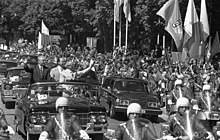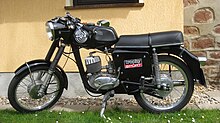MZ ETS
The ETS series (short for "single cylinder telescopic fork swing arm") is a motorcycle series from VEB Motorradwerke Zschopau (MZ), which was produced from 1969 to 1973. In addition to "ETS" as the factory name, there was also the name "Trophy Sport" for sales and advertising.
As with the MZ ES , there were essentially two versions of the ETS: the large (250 cm³) and the small (125 and 150 cm³) series.
At the end of the sixties, MZ only had motorcycles with full swing chassis in its range with the ES models . In order to meet the desire for a model with a sportier chassis, the largely unchanged ETS was developed from the basis of the ES.
The frame, motor and various add-on parts are almost identical to the ES types produced in parallel, only the position of the handlebar lock has been changed on the frame; this applies to both the large and the small series. As with almost all MZ models, many identical attachments, such as telescopic forks and fittings, were used for the large and small series.
The large series (175 and 250 cm³)
The large ETS was designed and manufactured in the late 1960s at the urging of Western European importers. The reason for this was the trend reversal abroad, away from the utility motorcycle with front wheel swing towards sporty motorcycles with telescopic fork .
In order not to have to forfeit too large production capacities for the new model, it was decided to base the ETS on the ES 250/2. In 1966, parallel to the development of the ES 250/2, the development of the ETS began by the designers around the engine specialist Roland Schuster and the main designer Manfred Thierfelder. The designers Giese and Kelm from the Office for Industrial Design were only given the task of redesigning the tank, bench and the front section.
Series production began in July 1969, which was a year late, as press tools for the sheet metal parts had not been delivered until 1968. There were also problems with the procurement of materials. So z. B. special steel can be bought especially for the telescopic fork in the "non-socialist economic area" . In order to stick to the familiar design, the decision was made to use the same telescopic fork that had already been installed in the off-road sports models. For the road machine ETS 250, however, this was changed accordingly. The front headlights and reflector, on the other hand, came from the BK 350 until 1971 and were only changed with the facelift model . The 17.5 hp engine, on the other hand, was largely taken from the ES 250/2. Improved in detail and provided with a higher compression, it now developed 19 hp and was also used in the ES 250/2 Trophy with the appearance of the ETS.
Unlike its sister, the ES 250/2, the ETS was not intended as a trailer machine . Although it had the ES frame suitable for tensioning, the telescopic fork was rather unsuitable for operation in a trailer. Series production as a team therefore did not officially take place. Apparently, however, six ETS teams were unofficially delivered to the German importer Neckermann in order to compensate for delivery problems with the ES team. From 1971 the facelift model was introduced. Instead of the black mudguards, the ETS was given a silver paintwork and optionally a yellow paintwork for the red one. A new headlight with greater light output and an optional high handlebar also increased the utility value. Due to the short construction time and the high foreign exchange costs, few ETS copies were built, even uncharacteristically MZ. A total of 16,275 machines left the factory from July 1969 to March 1973, with less than 50% of the machine destined for the Eastern Bloc. In order to be able to cover the domestic motorcycle needs, the following delivery allocation was made:
- 13,000 machines remained in the GDR,
- 1500 went to the FRG,
- 650 to France,
- 634 in the United Kingdom,
- 182 to Denmark,
- 102 to Iraq,
- 65 to Australia,
- 62 to Yugoslavia,
- 50 to Iran,
- 25 to the USSR,
- 4 to the US and
- 1 machine to Finland.
As of January 1, 2004, 201 MZ ETS 250 were still approved in the Federal Republic of Germany.
According to research by MZ enthusiasts, there were only 113 copies of the MZ ETS 175 built in 1969 and 1970, 100 of which were exported to Thailand. Another seven went to Czechoslovakia, one to the People's Republic of Poland and five remained in the GDR.
The small series (125 and 150 cm³)
The only difference between the two smaller models is the displacement. They also continued to use the almost unchanged frame of the small ES series, as well as the engine and various chassis parts. Only the tank was taken over by the Simson Sperber . There were problems with the telescopic fork, however, because the ETS 250 fork was initially too tight for the small models. In order to avoid this, the IFA combine decided that the small ETS should be equipped with the fork from the outdated RT 125/3 . However, the MZ designers around main designer Manfred Thierfelder thwarted this by changing the fork spring and oil level of the ETS 250 fork for the small ETS. As with the big ETS, there was also a facelift here . Of the approximately 15,000 ETS 125 and ETS 150 produced, 90 are still registered (as of January 1, 2019 according to KBA). With 4,000 units produced, the ETS 125 is also the rarest serial MZ model and is currently very popular. The small ETS were built in series from July 1970 to May 1973.
MZ ETS escort

Due to the small number of ETS built, it is now a sought-after collector's item. This is all the more true for the special models that were available from the ETS. The best known is the ETS 250 Escort. It was commissioned by the MfS in the early 1970s and 60 machines were produced. The GDR exported 30 copies to the People's Republic of Hungary, the other 30 received their own state services.
This custom-made model was intended as an escort machine for state vehicles. Unlike the series machine, the Eskort was equipped with the 5-speed gearbox from the off-road sport machines and two optionally switchable spark plugs. Lots of chrome, full fairing, and the square Wartburg headlights are the characteristic features of the escort. In order not to dup foreign state guests with a two-stroke exhaust flag, it was possible - with the appropriate oil quality - to run this machine with a mixing ratio of 1: 100. The collector's value of an ETS escort is difficult to measure, as only a few examples are known. A rough guideline value for condition 2 should be around 30,000 euros. However, the relationship between supply and demand is always decisive. There is likely to be a large imbalance here, since these motorcycles are in permanent collectors' hands or in museums, copies are only very rarely offered on the open market.
MZ ETS off-road sports models
In addition to the escort, there are also the ETS off-road sports machines, from which the abbreviation “ETS” comes. They had already appeared in the early 1960s parallel to the ES 250/1 and were largely responsible for the success of MZ at the international six-day race . The ETS off-road sports machines were available in the following cubic capacity classes: 175 cm³ ETS 175G; 250 cm³ ETS 250G and 300 cm³ ETS 300G.
Model overview
| ETS 125 | ETS 150 | ETS 175 | ETS 250 | ETS 250 escort | |
|---|---|---|---|---|---|
| Displacement | 123 cc | 143 cc | 172 cc | 243 cc | 243 cc |
| power | 10 hp | 11.5 hp | 14 hp | 19 hp | 19 hp |
| Empty weight | 114 kg | 114 kg | 149 kg | 151 kg | 160 kg |
literature
- Hans Müller: Factory export statistics 1951–1986 , VEB MZ, Zschopau, 12/1988
Web links
- Private page for the ETS250 from which much of the information in this article is taken
- MZ ETS 125/150/250 pages from ostmotorrad.de with operating instructions, spare parts lists, pictures, circuit diagrams and other information
- Original and advertising photos for the MZ ETS 250
Individual evidence
- ↑ a b Facts & Figures. (No longer available online.) In: ets250.com. Archived from the original on February 1, 2018 ; Retrieved December 25, 2016 . Info: The archive link was inserted automatically and has not yet been checked. Please check the original and archive link according to the instructions and then remove this notice.
- ↑ ETS 175 engine data ( Memento of the original from October 9, 2011 in the Internet Archive ) Info: The archive link was automatically inserted and not yet checked. Please check the original and archive link according to the instructions and then remove this notice. (accessed on May 17, 2011)



